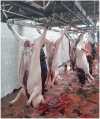Occurrence of Taenia species and Toxoplasma gondii in pigs slaughtered in Bujumbura city, Kayanza and Ngozi provinces, Burundi
- PMID: 39736692
- PMCID: PMC11686993
- DOI: 10.1186/s12917-024-04445-6
Occurrence of Taenia species and Toxoplasma gondii in pigs slaughtered in Bujumbura city, Kayanza and Ngozi provinces, Burundi
Abstract
Background: Taenia spp. and Toxoplasma gondii are foodborne parasites affecting humans and pigs. The magnitude of the burden of these parasites in pigs in Burundi is not known. Therefore, this study aimed to estimate the prevalence of Taenia spp. infections in pigs by meat inspection, partial carcass dissection and molecular confirmation and estimate the prevalence of Toxoplasma gondii infection in pigs by serology. A cross-sectional study was conducted in pig slaughter slabs located in Bujumbura city, Kayanza and Ngozi provinces. Multisampling strategies were used to sample 576 pigs. Upon pig slaughter, blood samples were collected to perform indirect ELISA for detecting antibodies against the T. gondii P30 protein in the serum. Routine meat inspection was carried out to detect T. solium and T. hydatigena cysticerci. The tongue, heart and masseter muscles were dissected by making slices less than 5 mm thick to estimate the intensity and stages of T. solium cysticerci. A subset of cysticerci and suspected lesions per infected pig were examined using PCR-RFLP to differentiate Taenia spp.
Results: Of the 576 pigs, 14 (2.4%) were positive for T. solium cysticercosis by meat inspection and 67 (11.6%) by partial carcass dissection. After molecular analysis, 66 (11.5%) samples were confirmed to be T. solium infections. The average of T. solium cysticerci in the dissected organs was estimated at 80 cysticerci. Most cysticerci (76.1%) were counted in the masseter muscles, followed by the tongue (18.8%) and the heart (5.1%). The majority of cysticerci (88.3%) were viable, 6.4% were calcified and 5.3% were degenerated. Approximately 69% of the pigs infected with T. solium had light infections, 13.4% had moderate infections and 17.9% had heavy infections. Thirty-two out of 576 pigs (5.5%) were suspected of being infected with T. hydatigena by meat inspection, but 24 pigs (4.2%) were confirmed molecularly to be positive for T. hydatigena infection. The seroprevalence of T. gondii infection in pigs was 17.7%.
Conclusions: This study indicates that T. solium and T. gondii parasites are endemic in Burundi and provides evidence of potential public health risks for the local population. Effective control strategies, including improved pig farming practices, better hygiene and sanitation, increased meat inspection, monitoring of infected pigs, risk-free culinary practices, and treatment of tapeworm carriers, should be implemented to avoid the perpetual contamination of pigs and humans with these zoonotic parasites.
Keywords: Taenia hydatigena; Taenia solium; Toxoplasma gondii; Burundi; Occurrence; Pigs.
© 2024. The Author(s).
Conflict of interest statement
Declarations. Ethics approval and consent to participate: The research protocol was approved by the Institutional Review Board of the Institute of Tropical Medicine (ITM) in Belgium (IRB/RR/AC/091 Ref 1595/22) and the National Ethics Committee in Burundi (CNE/25/2022). Permission and verbal consent were obtained from local administration, slaughter slab managers, butchers, and pig traders to collect pig blood and meat samples at the slaughter slabs. Consent for publication: Not applicable. Competing interests: The authors declare no competing interests.
Figures









References
-
- FAO/WHO. Multicriteria-based ranking for Risk Management of Food-Borne parasites. Microbiol Risk Assess Ser 23, 2014.
-
- Mahanty S, Garcia HH. Cysticercosis and neurocysticercosis as pathogens affecting the nervous system. Prog Neurobiol. 2010;91:172–84. - PubMed
MeSH terms
Substances
LinkOut - more resources
Full Text Sources
Miscellaneous

